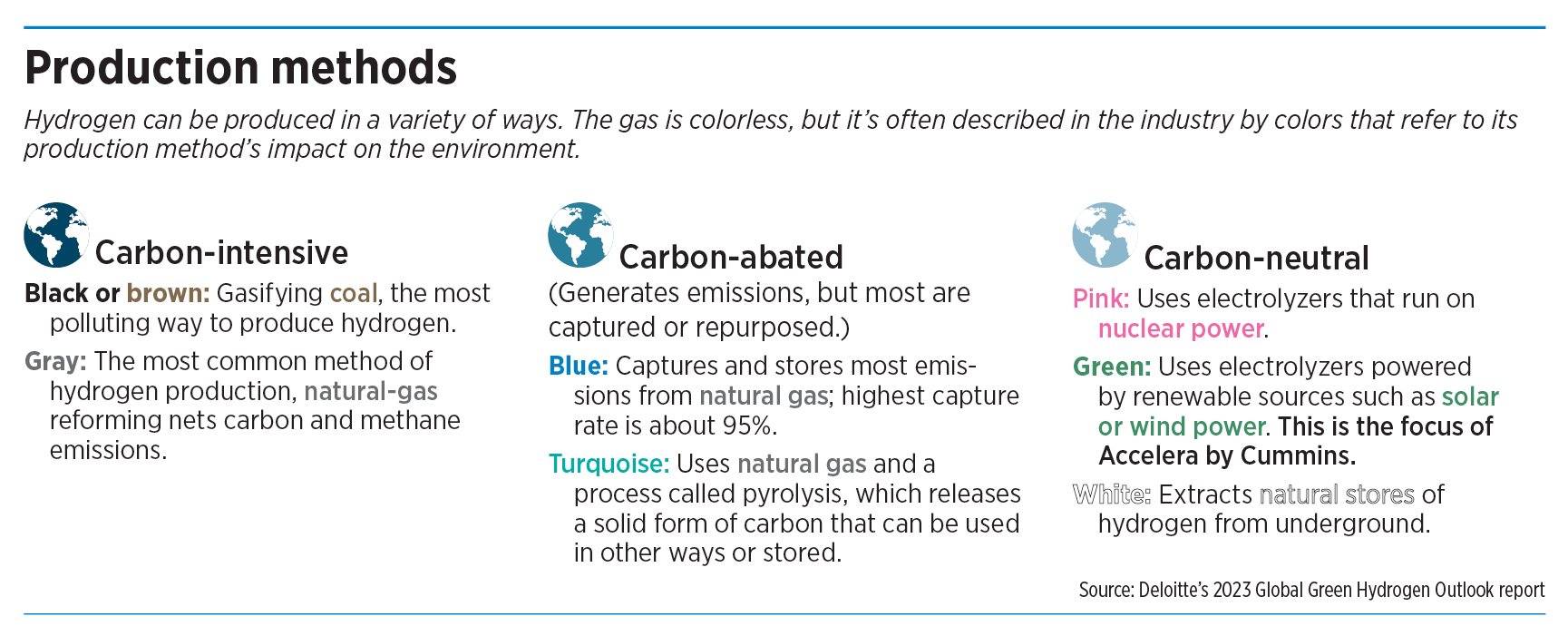Subscriber Benefit
As a subscriber you can listen to articles at work, in the car, or while you work out. Subscribe Now
When Cummins Inc. started investing in hydrogen power four years ago, the Columbus, Indiana-based manufacturer did so with optimism—but without certainty—that those investments would someday pay off.
That fog has started to lift. Cummins, which built its reputation on the strength of its diesel engines, is now confident that hydrogen is a huge growth market, even as questions linger about how quickly or broadly the technology will be adopted.
Cummins focuses on both hydrogen-powered and battery electric products through its zero-emissions business unit, which does business as Accelera by Cummins. But it’s hydrogen that is emerging as the breakout star for the company.

“Hydrogen is the single biggest growth opportunity that Accelera has,” said Alison Trueblood, the company’s Columbus-based general manager of fuel-cell and hydrogen technologies.
Cummins has gained significant traction in its hydrogen business within the past two years or so, in part due to the Inflation Reduction Act and the Infrastructure Investment and Jobs Act, two federal programs aimed at boosting the country’s emerging hydrogen industry.
Some of Cummins’ earliest wins in hydrogen happened in Europe, driven by the European Union’s clean-energy policies. Now, momentum has begun to build in North America.
Accelera held a media event this month in Quebec to show off what it describes as the first hydrogen-powered passenger train in North America. Accelera made the hydrogen fuel cells that serve as a power source for the train. And the hydrogen fuel in those cells was produced by an Accelera electrolyzer at a Quebec power plant.
The $1.2 trillion U.S. infrastructure bill, which passed in 2021, included $7 billion for a new U.S. Department of Energy program, H2Hubs, which aims to fund six to 10 clean-hydrogen hubs around the country. Indiana is in the running for one of those. The inflation-reduction bill, which passed in 2022, includes several provisions related to clean hydrogen, including a tax credit for hydrogen production.
And this June, the Energy Department published its “U.S. National Clean Hydrogen Strategy and Roadmap,” a document outlining how the country can build large-scale production of, and demand for, clean hydrogen. According to that document, the Energy Department aims to reduce the production cost of green hydrogen to $2 per kilogram by 2026 and $1 per kilogram by 2031. The 2020 baseline was $5 per kilogram.
These federal programs are playing a significant role in advancing the hydrogen economy, one industry adviser says.

Hydrogen has been on the horizon for decades, but it never really caught on until recently, said Mike McGowan, a Chicago-based hydrogen specialist with business consulting and services firm Deloitte. “The going joke has been, ‘Hydrogen’s 20 years away.’ It’s always been 20 years away.”
Thanks in part to the federal programs and clean hydrogen’s promise in fighting climate change, McGowan said, the current buzz about the fuel might actually have legs.
“It’s beginning to make commercial and operational sense … this one does seem for real.”
Cummins is a Deloitte client. For that reason, Deloitte declined to specifically comment on Cummins’ position within the hydrogen industry.
But others are talking about the manufacturer’s hydrogen ambitions.
In an August research report issued after Cummins released its second-quarter financial details, J.P. Morgan analyst Tami Zakaria wrote that Cummins “is positioning its business for a world that includes a transition away from internal combustion engines to alternative powertrains and will likely emerge as a leader in the hydrogen space, which we view as a positive.”
Zakaria noted that, in the near term, Cummins is raising its research, development and capital spending, and “may deliver lower returns for longer than anticipated.”
Growth goals
To be sure, Accelera’s revenue makes up a tiny fraction of Cummins’ overall revenue—and the zero-emissions business unit has lost money every year since it was formed in 2019.
Both of those situations are evolving.
In 2022, Cummins reported $28.1 billion in revenue, of which $198 million—less than 1%—came from the zero-emissions unit. Cummins has said it expects this year’s overall revenue to grow 15% to 20%, which would be $32.3 billion to $33.7 billion. In its Accelera unit, the company expects revenue of $350 million to $400 million—up to double what the unit earned last year. In 2025, Accelera could see revenue of $500 million, the company told investors at a conference last month.
Cummins said it expects Accelera to attain break-even status by 2027.
Looking ahead to 2030, Cummins has said it expects Accelera to earn $6 billion to $13 billion. The wide projection reflects the uncertainty involved in the industry’s transition to alternative fuels.

Matthew Elkott, who covers Cummins as an analyst for New York City-based financial services firm T.D. Cowen, said Cummins’ projection of a 2027 break-even date for Accelera is realistic.
“I do think it’s doable,” he said. “I have no reason not to think so.”
But Elkott said he has no view on the Cummins projection that Accelera will generate $6 billion to $13 billion in 2030. He said his financial modeling does not look that far ahead.
“Is it plausible? Maybe,” he said. “It’s going to depend, I guess, on what happens in the world.”
The outcome of the 2024 presidential election is one factor that could affect the momentum behind green hydrogen, Elkott said.
Accelera has multiple products in its hydrogen business. It makes electrolyzers—equipment that uses electricity to split water into oxygen and hydrogen gas. The hydrogen gas can then be liquified or compressed and used to power fuel cells. The company also makes fuel cells—technology that uses a chemical reaction to combine hydrogen and oxygen, creating electricity.
Of that $6 billion to $13 billion projection, about half is expected to come just from Accelera’s electrolyzer business.

“Electrolyzers is probably the single biggest outgrowth opportunity that Cummins has,” said Accelera’s managing director of hydrogen technologies in the Americas, Alex Savelli. Based in Minneapolis, Savelli’s job is to scale up the company’s electrolyzer business in the Americas.
Accelera’s focus is on what’s known in the industry as green hydrogen—hydrogen produced by electrolyzers that are powered by renewable-energy sources such as the sun or wind. The process is carbon-neutral, meaning it does not produce greenhouse-gas emissions that contribute to climate change.
Right now, most of the world’s hydrogen is manufactured through a process called natural-gas reforming, or gray hydrogen. This process generates both carbon and methane emissions.
But the Biden administration is actively working to boost the nation’s clean-hydrogen economy.
“The Inflation Reduction Act and the bipartisan infrastructure law, and the [CHIPS and Science Act]—all of that really put things on steroids in the Americas,” Savelli said.
The CHIPS Act, he said, is significant to the hydrogen industry because hydrogen is used in making microchips. Among its other provisions, the CHIPS Act allocates $52.7 billion for U.S. semiconductor research, development, manufacturing and workforce development.
In Indiana alone, several semiconductor projects have already been announced, including a $1.8 billion research and development and production plant slated for West Lafayette that Minnesota-based SkyWater Technology announced in 2022.
Significant projects
In addition to the Canadian hydrogen-powered train, Accelera has notched several other significant hydrogen wins.
In February 2022, Florida Power and Light—the nation’s largest electric utility—announced that Cummins would supply it with a 25-megawatt electrolyzer system for Florida’s first green-hydrogen plant. The electrolyzer system has the capacity to produce 10.8 tons of hydrogen per day.
In December, Cummins announced it would supply a 35-megawatt electrolyzer system to England-based Linde Plc for a hydrogen production plant in Niagara Falls, New York. Linde, an industrial gases and engineering company, said it expects to add several other U.S. electrolyzers following the initial project in New York to keep up with expected demand for green liquid hydrogen.
In March, Accelera announced it would supply a 90-megawatt electrolyzer system for the Varennes Carbon Recycling plant in Quebec. The system is expected to go into operation in 2025.
“Some of the projects we are discussing with our customers, they’re getting larger and larger,” Savelli said.
Because of the promise Accelera sees in electrolyzers, one of its priorities is to scale up production capacity for those products.
Cummins entered the hydrogen market in 2019 when it acquired a majority stake in Canada-based Hydrogenics, which has electrolyzer manufacturing facilities in Canada and Belgium. (Earlier this year, Cummins became the full owner of Hydrogenics by acquiring the remaining 19% stake in the company from France-based Air Liquide.)
Cummins began U.S. production of electrolyzers this May, repurposing 89,000 square feet at a Cummins plant in Fridley, Minnesota. That plant currently has annual production capacity of 500 megawatts, with the ability to double capacity to 1 gigawatt.
The manufacturer also recently opened an electrolyzer plant in China, and the company’s fifth such facility, in Spain, is expected to begin production early next year.
Indiana’s part
So how do Cummins’ Indiana operations fit into the company’s hydrogen plans?
Cummins’ hometown of Columbus is the location of one of the company’s three fuel-cell research labs, along with sites in California and China.
As of now, the company makes electrolyzers and fuel cells at only a handful of locations, none of them in Indiana. Accelera’s three fuel-cell production sites are in Canada, Germany and China.
Similar to what it did at the Fridley plant in Minnesota, Trueblood said, Cummins plans to expand its hydrogen business to its other existing facilities “once the market is ready.”
The company isn’t sharing details about when that might happen or where those conversions might take place, Trueblood said.
She did suggest, though, that conversions will happen at Hoosier facilities at some point.
“Indiana is important and a special place for Cummins, and I can’t imagine us not continuing to have a presence [here] with our new technology,” she said.•
Please enable JavaScript to view this content.



This IS the future, bye-bye battery/EV